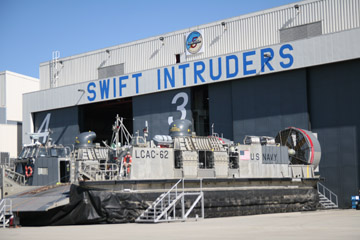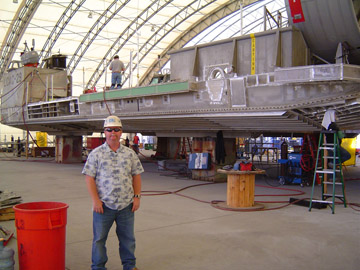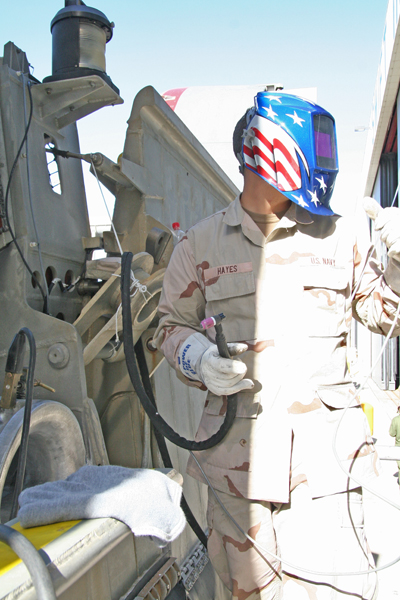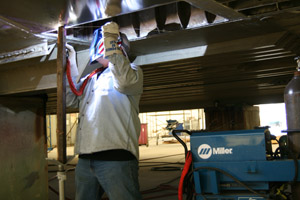Executive Summary
- The Dynasty 300 DX controls the arc characteristics and the amount of heat put into the weld.
- Burn-through and warping prevented through advanced controls.
- Low amp draw makes Dynasty 300 more energy-efficient than transformer-based machines.
Advanced TIG Welders Keep Navy, Marines Walking On Air
“No beach out of reach,” –Assault Craft Unit Five’s (ACU-5 – “The Swift Intruders”) motto
|
|
| One of the U.S. Navy's LCACs (Landing Craft, Air Cushion) "on cushion." |
Commissioned in 1983, ACU 5 has been tasked with the high speed transfer of personnel, equipment, and supplies from ship to shore and inland to designated landing areas. To accomplish this, the unit relies on a unique hovercraft, the Navy’s Landing Craft, Air Cushion (LCAC).
Riding on a cushion of air, the LCAC can transport an M1A1 tank, 24 Marines or other 75-ton payload at speeds of up to 40 knots for distances of 200 miles. A traditional landing craft traveled at 8 knots, could access only about 17 percent of the world’s beaches and delivered its cargo or troops at the beach. An LCAC, on the other hand, can access about 80 percent of the world’s beaches and can carry its cargo far inland, clearing obstacles of up to four-feet high.*
With their high speed and increased range, LCACs can launch from their parent ship, which remains out of sight over the horizon, and quickly make their way inland. This maximizes the element of surprise, reduces exposure to enemy fire and, because of their high speed, allows them to coordinate with helicopters during an amphibious assault. LCACs have deployed in Operation Desert Storm, Operation Iraqi Freedom, Somalia and have even conducted humanitarian missions of Tsunami relief, Hurricane Katrina relief and Firefighting support on Catalina Island, Calif.
 |
|
The calm before the storm. This LCAC of ACU 5 “The Swift Intruders” is getting ready for deployment.
|
Aging Fleet Stays Shipshape
There are 80 LCACs in service, each operated by a crew of five enlisted personnel and powered by four TF40B gas turbine engines that produce 4,000 hp each. Constructed by Textron Marine and Land Systems and Avondale Gulfport Marine, LCACs were designed with a 20-year service life. Now, having reached the 20-year mark and with no additional craft being manufactured, the Navy has undertaken a Service Life Extension Program (SLEP) to extend the life of the craft by 10 years.
SLEP work might consist of upgrading systems, replacing engines and repairing structural components, including replacing damaged areas on the underside of the deck or “buoyancy box.”
Contracted through L-3 Communications Unidyne, Walashek Industrial & Marine (http://www.walashek.com/) are performing the SLEP work at Camp Pendleton, Calif., for the U.S. Navy. With headquarters in Seattle and locations around the country, Walashek has a reputation for performing complete overhaul and repair of marine boilers, structural and piping system fabrication and other specialized ship repair, including work on the aircraft carrier USS Nimitz.
“The LCAC takes quite a beating,” says Paul Hicks, program manager for Walashek. “They transition from on cushion over water and land and various beach environments and parking in support ships under varying sea conditions and can adjust to the operating environment and is constantly battered about by the seas.”
 |
| Paul Hicks is program manager for Walashek, the company undertaking the Service Life Extension Program for the LCACs. His job is to add years to the aging fleet. |
A peripheral skirt system holds the cushion of air and connects to the LCAC’s buoyancy box, which is designed to keep the craft afloat even if it goes “off-cushion” and the skirt is deflated. The buoyancy box receives a majority of the attention due to the effects of the corrosive ocean environment and vibration related cracks.
Everyone concerned with maintaining the LCACs is acutely aware that United States military personnel lives are at stake each time the crafts head to sea, and they perform their tasks accordingly. Every inch of the craft is inspected, and suspect areas are marked for repair or removal and replacement.
While Walashek works to extend the service life of the crafts, nearby on the base, Navy hull technicians (HTs) perform the pre- and post-deployment maintenance that keep the LCACs running on a regular basis. Gary Wheeler, ACU-5’s onsite representative from CACI, trains the HTs in the fine art of TIG welding the aluminum craft.
 |
|
Navy Hull Technicians are responsible for regular maintenance of the LCACs, performing pre- and post-deployment repairs.
|
Regardless of prior welding experience, when HTs enter the program, it’s Wheeler’s job to start from the beginning and teach them the theory, machine operation, metallurgy and welding techniques they’ll need to earn their Navy certification to weld on the aluminum LCACs. These efforts saves the command up to $1 million each year since ACU-5’s personnel can perform welding and maintenance that would otherwise be contracted out.
Walashek draws on its many years of welding experience and skilled workforce to perform the SLEP work.
“With our experience in boiler work and other welding-critical projects, we’ve got pipe fitters, boiler makers, steam fitters and some top-of-the-line welders working for us,” says Paul Hicks, program manager for Walashek. Yet, regardless of an individual’s previous experience, to qualify for working on the LCAC, Walashek’s welding operators must pass overhead, horizontal and vertical x-ray welding tests. Each completed production weld is tested using dye penetrant.
To meet the challenge, both the Navy and Walashek chose the Miller Dynasty 300 DX AC/DC TIG welder for its advanced squarewave output and aluminum welding capabilities.
The Problem With Aluminum
“Aluminum is a unique alloy that presents some special welding challenges,” says Wheeler. “For instance, steel changes color as it heats up; however, aluminum maintains the same color whether it’s solid or liquid, making it difficult to determine the temperature of the alloy. This means it’s easier to put too much heat into the weld and burn through the material.
“Aluminum also has a thick, heavy oxide on it, which melts at about 3,600-degrees F, while the aluminum itself melts at about 1,075-degrees F. This requires the welder to disrupt the oxide by mechanical abrasion and the welding arc [Electrode Positive part of the AC welding current]. If it’s done correctly, after the weld is complete, the oxide will reform within eight hours to protect the weld and the plating for the rest of its life cycle.”
If the oxide is not removed properly, the aluminum will melt below the oxide and the fusion will not be sufficient to carry the LCAC. So AC output is necessary for TIG welding aluminum because it combines the cleaning action of Electrode Positive (EP) to remove the oxide layer on the metals with the penetration of Electrode Negative (EN).
Weapon of Choice
The Dynasty 300 DX AC/DC TIG welder allows the user to precisely control the arc characteristics and the amount of heat put into the weld, which helps prevent the burn-through and warping that might occur on thin material and ensures better penetration. These capabilities made it the ideal choice for keeping the LCACs shipshape.
 |
| The Dynasty 300 DX was chosen for its ability to fine tune the welding arc, operator ease-of-use and low amp draw; Walashek uses half the generators they would need if they were to use transformer-type welders. |
The Dynasty 300 DX provides a 5- to 300-amp output range (250 amps at 40- percent duty cycle), and permits adjusting frequency from 20 to 250 Hz and adjusting EN duration from 50 to 90 percent. By fine tuning EN duration and AC frequency, operators can stabilize the arc, reduce arc wandering, obtain excellent directional control over the arc and puddle, establish the weld puddle faster, precisely place the filler and control bead width.
The desired arc cone shape and weld bead profile determine the frequency to be used. An arc cone at 200 Hz is much tighter and more focused than an arc cone operating at 60 Hz. At higher frequency, there is significantly improved arc stability and increased penetration, making it ideal for fillet welds and other fit ups requiring deep, precise penetration.
Pieces with wider gaps to fill or that require build up will benefit from decreasing the frequency. The longer the arc spends in each polarity, the longer it has to spread itself out to the nearby metal and the softer and wider the arc cone that results.
“On fillet welds and lap weld joints we change the frequency to 200 Hz,” Wheeler says. “This minimizes some challenges for the welding machine operator in that it minimizes melt through, burn through and some other defects. On a butt weld, where we’re putting two pieces together, we change the frequency to 60 Hz, keeping the arc on longer and getting adequate fusion.”
“With aluminum if your welds are too large and you’re putting in too much heat into the base metal, you’re going to warp it. It will turn into a pretzel,” says Hicks. “But the Miller Dynasty gives us the ability to adjust our parameters…to tighten up our beads, control our heat better, and increase our travel speed, which also leaves less heat. Plus, it’s a simple machine to operate.”
Hicks offers the following tip, “A lot of guys will think that if you want to put less heat on something, you need to turn your amperage down. Well, it’s actually the opposite. To decrease the heat transferred to the metal, increase your amperage so you can increase your travel speed.”
When it comes to balance control, more cleaning action is not necessarily better. A good weld requires only a .1-in. of etched zone surrounding the weld, although different joint configurations may have different requirements. Using the least amount of cleaning action necessary (setting the balance at the highest practical EN) helps maintain the tungsten point, reduces balling and provides for deeper, narrower penetration. Insufficient cleaning action results in a “scummy” weld puddle. Too much cleaning action can lead the tungsten tip to ball and reduce penetration.
“We set the electrode to 70% EN,” says Wheeler. “At that setting, we get good cleaning action while extending tungsten life, since it puts more heat in
the base material than in the electrode.”
Although the Dynasty 300 DX has given way to the Dynasty 350, which adds more power, more advanced waveshapes (squarewave, soft squarewave, triangular and sine wave) and independent current control, Walashek will likely continue using their current machines.
|
|
| Every Walashek welder working on the LCACs must be certified in overhead welding and pass an x-ray test to prove it. Each actual weld is tested with dye penetrant. |
“I’ve been running 17 Dynasty 300s for the past two years and they run just as good today as they ran the day we bought them. Their durability has been great, and they pack a whole lot of punch into a little box. It does everything we need it to do.”
Thus armed with the Dynasty 300, Navy HTs and Walashek welders will do their part to ensure that no beach remains out of reach.
SIDEBAR
Because Walashek uses generators to power their welding units, the Dynasty’s low power draw helps keep the company on budget.
“Because they’re inverters, the Dynastys don’t pull as much amperage as a transformer machine,” says Hicks. “We’re getting a tremendous amount of power from them. We’re welding at anywhere from 260 to 280 amps ten hours a day, five days a week with all of these machines. And running that much amperage, we’re only pulling about maybe 18 amps, maybe 20 amps a machine of input power. If we were running transformer machines we’d be doing at least 30, 35 amps, so we’d have to have twice as many generators and use twice as much fuel.”
(*According to http://www.fas.org/man/dod-101/sys/ship/lcac.htm).